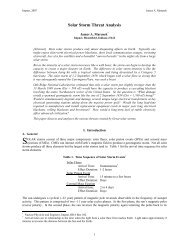THE COSMIC CLOCK, THE CYCLE OF TERRESTRIAL ... - Impact
THE COSMIC CLOCK, THE CYCLE OF TERRESTRIAL ... - Impact
THE COSMIC CLOCK, THE CYCLE OF TERRESTRIAL ... - Impact
You also want an ePaper? Increase the reach of your titles
YUMPU automatically turns print PDFs into web optimized ePapers that Google loves.
2 nd International Conference on Global Warming and the Next Ice Age (2006) TP-10<br />
cadmium, chlorine, iron, fluorine, lithium and potassium) are very efficient at absorbing nuclear particles once they<br />
have been slowed down (thermalized). Seawater, which contains chlorine (~19,400 ppm.) and potassium (~392<br />
ppm.) at 3.5% salinity, provides dramatic improvements to the capture efficiency over pure water (e.g., evaporated<br />
ocean moisture). As a result, GCR interactions with lofted seawater droplets localize and concentrate the ionization<br />
within the aerosol/cloud structure.<br />
I<br />
IV. Recent Experimental Studies<br />
t has been suggested that trace amounts of sulfur dioxide in the Earth’s atmosphere might be the primary<br />
contributor to GCR induced aerosol nucleation which condenses to form clouds. Recently Svensmark et al.<br />
[2007] conducted experimental studies of aerosol nucleation in air containing trace amounts of ozone, sulfur dioxide<br />
and water vapor. The results showed the nucleation process under atmospheric conditions is proportional to the ion<br />
density. In other words, cloud cover increases when the intensity of GCR ionization increases and decreases when<br />
the intensity declines.<br />
In this paper, I suggest that nucleation of marine aerosols is the primary contributor of hurricane cloud formation.<br />
This hypothesis could be tested through a similar experimental study.<br />
T<br />
V. Low Atmospheric Pressure Systems<br />
he development of a low atmospheric pressure system is one of the observed parameters used by hurricane<br />
forecasting experts to<br />
predict hurricane<br />
development. Hurricane<br />
intensity is often measured<br />
as a function of barometric<br />
pressure. Areas of low<br />
pressure are favorable to<br />
the rising air that feeds<br />
hurricane development.<br />
Low Caribbean sea level<br />
pressures correspond to<br />
more frequent and more<br />
intense Atlantic hurricanes<br />
and the low pressure<br />
systems precede the<br />
hurricane activity by<br />
several months [Landsea<br />
et al., 1999].<br />
One phenomenon<br />
that can explain hurricane<br />
development and rapid<br />
growth of cloud structures<br />
that support hurricanes<br />
relates to increased GCR<br />
penetration depth. As air<br />
molecules thin out in an<br />
atmospheric pressure low,<br />
cosmic rays and the<br />
shower of secondary<br />
particles they spawn are<br />
able to penetrate deeper<br />
through the atmosphere<br />
resulting in a surge of<br />
ionization near the Earth’s<br />
surface.<br />
The Bartol Research<br />
Institute operates an 18-<br />
Pressure (mm Hg)<br />
Uncorrected Neutron Count<br />
770<br />
765<br />
760<br />
755<br />
750<br />
745<br />
740<br />
735<br />
730<br />
725<br />
5500<br />
5000<br />
4500<br />
4000<br />
3500<br />
0 20 40 60<br />
Hours<br />
0 20 40 60<br />
Hours<br />
Figure 3. Compares the drop in atmospheric pressure with a surge in GCR<br />
penetration during the Thule, Greenland storm. The graph covers the storm period<br />
from 1000 UT on 18 February 2005 through 2300 UT on 20 February 2005. [Bartol<br />
Research Institute Dataset, 2005]<br />
3




